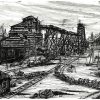Bulldog Days of August
Written by Wendi Blewett, DLNHC Collections Manager
We all know what it means when something is ‘built like a Mack truck.’ It’s solid. It’s sturdy. It’s powerful. Mack has a long history of building durable heavy-duty vehicles, and it all started with Jack Mack and his interest in commercial transportation.
America’s best known truck company had its beginnings in Lackawanna County, Pennsylvania, with the birth of John “Jack” Mack in the mid-1860s. Fueled by an interest in machinery, he held several transportation jobs in Northeastern Pennsylvania and New York. By 1890 he was in Brooklyn, working at the carriage and wagon manufacturing company of Fallesen and Berry. In three short years he and brother Augustus “Gus” Mack bought the company after Fallesen retired. The following year their brother William Mack joined them. They shifted gears and began experimenting with steam and battery-operated motors.

The Mack Macungie Assembly Plant, from a slide from the National Canal Museum collection.
In 1900 they were approached to create a sightseeing bus for a Prospect Park sightseeing business. This gasoline vehicle was the first to carry the Mack nameplate but was called the ‘Manhattan’ to avoid confusion with the Macks’ horse-drawn wagons. In 1901 the brothers filed a certificate of incorporation for the Mack Brothers Company. A second sightseeing bus was ordered, and the company began to gain traction.
Driven by the demand for more Manhattan buses, the brothers started looking for a larger factory space where they could also design and build their own motors. Brother Joseph Mack suggested Allentown, where he operated a silk factory, and in 1905 the Macks moved onto the site of the former Weaver-Hirsh foundry in south Allentown. Allentown was the ideal location for their commercial transportation company: perfectly situated between the major cities of Philadelphia to the south, Reading to the southwest, and Scranton and Wilkes-Barre to the north. It also boasted a wide variety of businesses, including foundries, machine companies, and cement, cigar, and textile industries. That same year the Mack Brothers Motor Car Company was incorporated.
Over the next several years, Mack’s company accelerated forward. They designed and built specialized vehicles, introducing rail cars and locomotives in 1905, the seat-over-engine model in 1906, dump trucks with an under-body hoist around 1907, and a line of fire engines in 1910. That year they also retired the trade name ‘Manhattan’ in favor of ‘Mack’, and fifth brother Charles Mack joined the company. At that point, the Mack brand and reputation had begun travelling around the United States, and there were several Mack dealerships along the east coast. Mack joined the Saurer Motor Company to form the International Motor Company (IMC) in 1911, and the following year the Hewitt Motor Company joined them. In 1912 Jack, Gus, Joseph, and Charles Mack left the company. Jack formed the Maccar Company with Roland Carr in Allentown. Gus and Charles steered towards San Diego, followed by Joseph a few years later. Only William Mack remained, and he stayed at Mack until the 1920s.

The Mack Bulldog design is relatively unchanged from its original 1932 design – a slight redesign in 1979 gave it shorter ears and tail, making it more ergonomic.
The exodus of the Mack brothers could have caused the combustion of the Mack Brothers Motor Car Company, but their successors, including Edward R. Hewitt and Alfred F. Masury, were able to dodge disaster. Their new AB Model was introduced in 1914 to great popularity, and the 1916 AC Model overtook it in popularity, especially with its use in World War I. The British ordered 150 AC Models in the Spring of 1917 and soon nicknamed the machine the “Bulldog” for its likeness to a British Bulldog in appearance, tenacity, and performance. Within a few years a new mascot was introduced: a bulldog tearing up a book titled ‘Hauling Costs.’ It was used in advertisements and on the Mack nameplate. By this time, the Hewitt and Saurer vehicle lines had been discontinued, and in 1922 the title of the parent company was changed to Mack Trucks, Inc. Not a company to remain idle, the 1920s saw Mack introduce nine models into the A series and new B series. They were also granted over 270 patents between 1919 and 1927. The Federal Highway Act of 1921 literally paved the way for increased road use and trucking, and at the head of the pack was Mack Trucks. Tragically, founder Jack Mack passed away in a car crash in 1924. He was laid to rest in Allentown, in a cemetery near the former Mack plant.
Mack Trucks continued to develop new models and improve existing designs, introducing its own diesel engine in 1938. Another new addition was that of a bulldog hood ornament, patented by Alfred F. Masury, Mack’s Chief Engineer in 1932. Though the AC ‘Bulldog’ model was retired in 1939, the bulldog remains Mack’s mascot to this day.
Mack is still a driving force in the modern-day trucking industry, producing a wide variety of heavy-duty vehicles for every commercial transportation need. The company headquarters stayed in Allentown until 2009, when it relocated to Greensboro, North Carolina, but Mack Trucks, Inc. still has a presence along the corridor in the form of its Lower Macungie Township Assembly facility, now known as Mack Lehigh Valley Operations. This facility, opened in 1974, is responsible for the assembly of all heavy-duty Class 8 Mack trucks for the North American market.
Sources
- https://www.macktruckshistoricalmuseum.org/mack-history/
- https://www.macktrucks.com/about-mack
- Heilig, John. Mack: Driven for a Century. Publications International, 1999.
- Montville, John B. Bulldog. Aztec Corporation, 1979.
- Montville, John B. Mack. Haessner Publishing, 1973.























Join the Conversation!